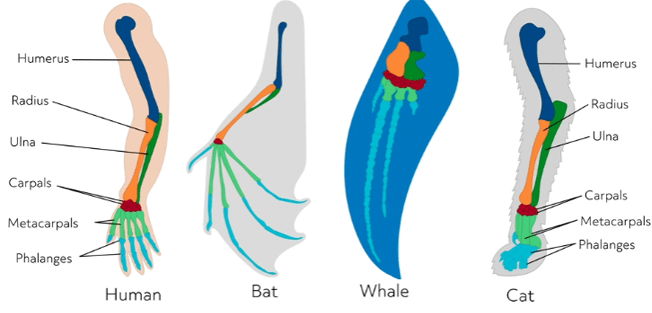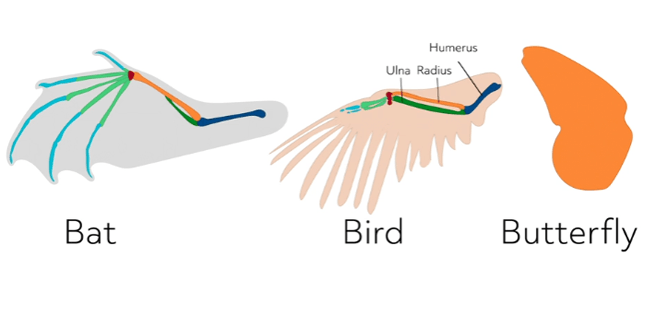
Hi, and welcome to this review of homologous and analogous structures! Today we’ll be talking about the properties of these structures by going through a couple of examples and seeing how each property applies to organisms in real life. Let’s get started!
Homologous Structures
When comparing homologous structures, we are comparing the anatomy of one part of an organism to another and finding it to be structurally similar but functionally may be different.
Homologous Structures Examples
Let’s compare a couple of tetrapods, specifically a human arm and a cat arm. Both the human arm and the cat arm have a single bone in the upper arm, which we call the humerus, followed by two bones in the forearm–the radius on the more medial side and the ulna on the more lateral side. Both arms also have a common wrist structure followed by a grouping of metacarpals and phalanges.
All of these structures are similar; however, these structures do not have the same function. Cats are quadrupeds that use their arms for walking and maybe a little climbing and hunting for outdoor cats. Humans, on the other hand, use their arms and hands for gross motor movement like grabbing, hugging, and lifting, as well as fine motor movement like using tools or even communicating.
A whale flipper and a bat wing are also homologous structures in the same sense as a human arm and cat arm with a humerus, radius and ulna, and so on. But the whale’s “arm” is actually a flipper that it uses to swim while the bat uses its wing to fly.

What’s the significance of all of this? Well, some evolutionary biologists use homologous structures as evidence for divergent evolution. The hypothesis stands that if two structures have similar morphology but are used for different purposes, both organisms have evolved from the same origin, or are derived from a common ancestor. This can be further tested by comparing the results of gene sequencing. Actually, if we break down the word, the prefix “homo-“ means “the same,” referring to the common ancestry. This can be helpful to remember.
Analogous Structures
Now let’s look at analogous structures. Analogous structures have different morphology, which means they are different in structure but have similar function. Let’s take our bat wing again, and this time compare it to a butterfly wing and a bird wing. The bone structure of the bat wing is closer to the bone structure of a human arm than it is to a bird wing. Bird wings have a single humerus that branches into a radius and ulna, but birds don’t really have a wrist complex or distinct metacarpals or phalanges. Butterfly wings don’t have any bones at all.
Clearly, these structures are anatomically different, but interestingly enough they all allow for flight. They all have different morphology, but have similar function. This is significant because organisms with analogous structures likely do not have a common shared ancestor but have evolved from different origins. This is why analogous structures are sometimes used as evidence for convergent evolution. This is the idea that species started out independently of one another and grew more alike over time.

Another example of analogous structures are dolphins and sharks as whole species. Although we might think of dolphins and sharks as being relatively similar, their morphology says otherwise. Dolphins are mammals that have live births and have fins with a homologous structure to human arms. Sharks are fish that lay eggs and have fins with different bone structure than what is found in dolphins and humans.
Dolphins use echolocation to hunt and communicate, while sharks have heightened olfactory senses for sniffing out the blood of their prey. However different dolphins and sharks are structurally and physiologically, they have evolved to be similar in function. Both dolphins and sharks use their fins to swim and have bodies that are streamlined for an aquatic environment. In fact, it was likely the pressure of their shared environment that pushed them towards this sort of convergent evolution.
Review
Okay, now that we’ve covered the differences between homologous and analogous structures, let’s go over a couple of review questions.
1. True or False: Structures that have different morphology but similar functions are homologous.
2. True or False: Organisms with analogous structures did not come from shared ancestors.
That’s all for this review! Thanks for watching, and happy studying!